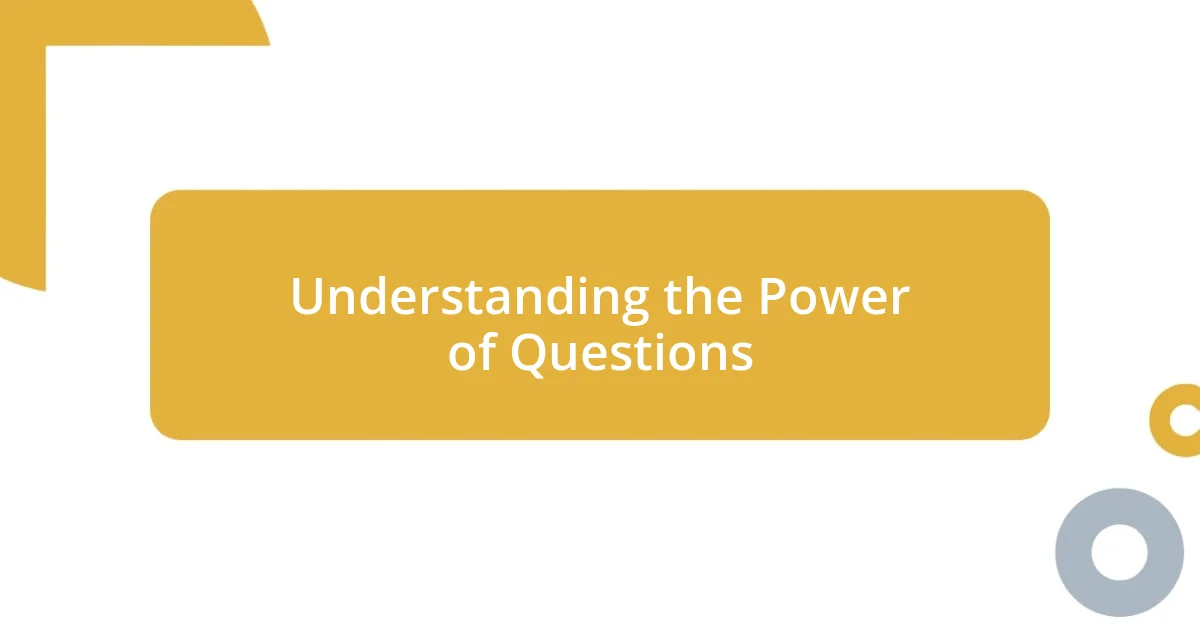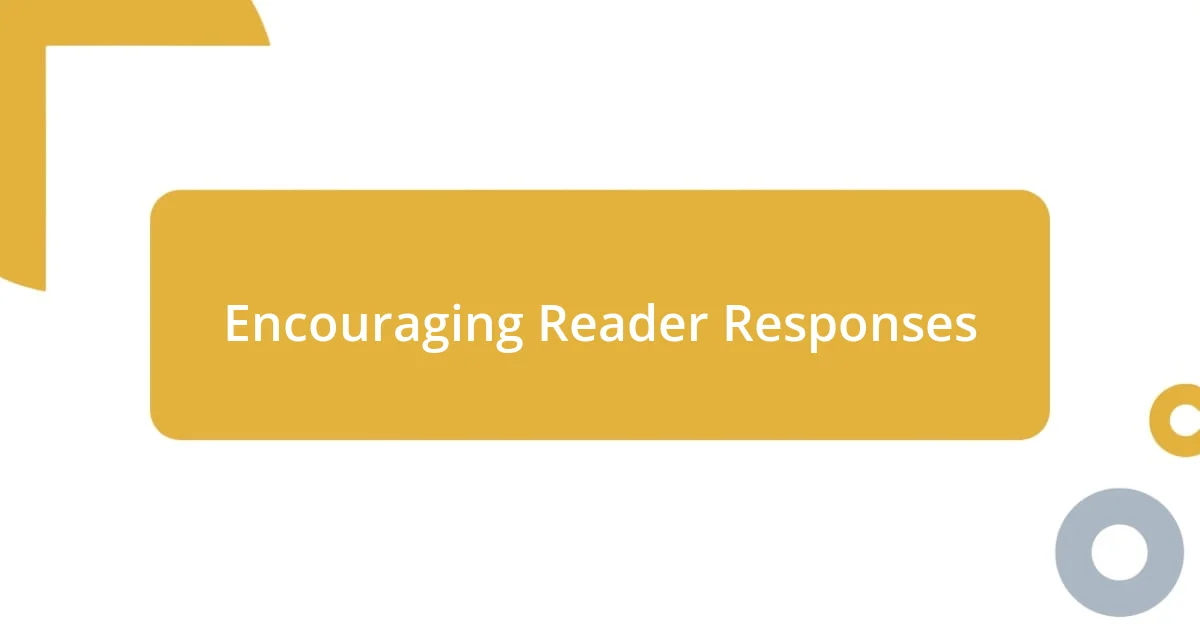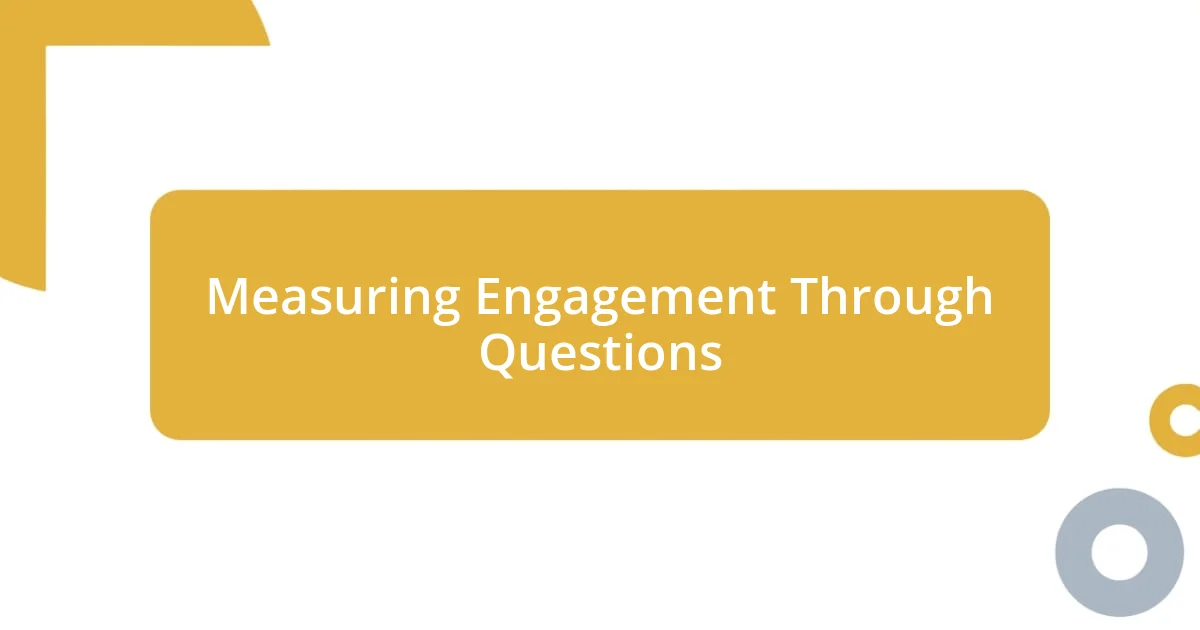Key takeaways:
- Questions foster engagement and create connections, making readers feel valued and involved in discussions.
- Different types of questions—open-ended, yes-or-no, and rhetorical—serve distinct purposes in encouraging deeper thinking and dialogue.
- Strategically incorporating questions throughout content enhances emotional connection and community among readers, driving richer discussions and insights.

Understanding the Power of Questions
Questions have a unique ability to spark curiosity and create a dialogue. I remember a moment in a workshop where I posed a challenging question: “What if failure was just a stepping stone to success?” The room fell silent, but the expressions on my participants’ faces told me they were deeply engaged, pondering their own definitions of success and failure.
When I think about how questions create connections, I reflect on a book club I once joined. I often found that the most insightful discussions arose not from the text itself, but from the questions we asked each other. It’s intriguing how a well-placed question can shift perspectives, inviting everyone to share their interpretations and experiences, enriching our collective understanding.
Additionally, I’ve noticed that asking questions makes readers feel valued and heard. I often wonder, why is it that we instinctively feel more invested when someone asks for our opinion? In my experience, engaging with readers through questions fosters a sense of community, as if we were diving into a conversation rather than a monologue.

Types of Questions for Engagement
When it comes to involving readers, the type of questions you pose can significantly impact engagement. Open-ended questions are particularly effective, as they invite a range of responses and encourage deeper thinking. I recall a time during a panel discussion when I asked, “How does this topic resonate with your own experiences?” The varied responses not only enriched the conversation but also built connections among participants who found common ground in their experiences.
Yes-or-no questions serve a different purpose. They are quick and straightforward, often facilitating immediate reactions. I remember using a simple, “Have you ever felt overwhelmed by choices?” at a networking event. The nods around the room instantly confirmed that everyone could relate, leading to lively discussions about decision-making and its challenges. Such questions can initiate further dialogue and provide a platform for exploring more complex issues.
Rhetorical questions are another tool in my kit, designed to provoke thought without expecting a direct answer. For example, I often ask, “What would happen if we embraced curiosity in our everyday lives?” This question leaves everyone reflecting, creating a subtle yet powerful shift in perspective. I find that these questions allow readers to connect emotionally with the topic, as they consider their own experiences in relation to the inquiry.
| Type of Question | Purpose |
|---|---|
| Open-ended | Encourage diverse responses and deeper discussions. |
| Yes-or-No | Facilitate quick reactions and spark immediate dialogue. |
| Rhetorical | Provoke thought and encourage personal reflections. |

Crafting Open-Ended Questions
When crafting open-ended questions, I find it crucial to tap into the emotions and experiences of my audience. For example, during a recent writing retreat, I asked participants, “What story has shaped who you are today?” The moment the question left my lips, I could see eyes lighting up, and smiles breaking across faces. Each person had a tale to share, and the energy in the room transformed into a safe space for personal reflections. This experience reinforced my belief that such questions not only open the floor for responses but also foster a sense of vulnerability and connection.
To make your open-ended questions truly engaging, consider the following tips:
- Relate to personal experiences: Start by reflecting on your own journey to resonate with your audience.
- Be specific but broad enough: Aim for clarity in your question while allowing for diverse perspectives.
- Invite storytelling: Encourage others to share anecdotes, turning responses into meaningful exchanges.
- Use visual imagery: Paint a vivid picture that invites readers to step into the scenario and engage on a deeper level.

Using Rhetorical Questions Effectively
Rhetorical questions can act as catalysts for deeper thinking, often causing readers to pause and reflect. I remember a writing workshop where I mused, “What would shift in your life if you prioritized your passions?” The room fell silent, but I could see wheels turning in people’s minds. This kind of question is powerful; it doesn’t need an immediate response but rather prompts personal exploration, which is where real engagement begins.
I often incorporate rhetorical questions to steer narratives in ways that resonate emotionally with readers. For instance, I asked myself, “How would my routines change if I infused joy into the mundane tasks?” Reflecting on this shifted my perspective on daily activities, transforming them into opportunities for mindfulness. Questions like these encourage readers to share in that emotional journey, inviting them to rethink their own routines and the emotions tied to them.
Using rhetorical questions isn’t just about their content; it’s also about timing and placement. Just last month, I was penning a piece on self-discovery, and I used the line, “Isn’t it fascinating how our toughest challenges often lead to our greatest growth?” This tiny pause in the narrative allowed readers to connect the dots from their challenges to their personal growth. When employed thoughtfully, rhetorical questions can enrich the reader’s experience by inviting introspection without putting them on the spot.

Incorporating Questions into Content
Incorporating questions into my content isn’t just a technique; it’s an art form that connects me to my readers. Recently, while drafting an article about resilience, I posed the question, “What’s the most unexpected strength you’ve discovered in yourself during tough times?” The moment I wrote it down, I realized how it could resonate deeply. I remember feeling that rush of excitement as I envisioned readers reflecting on their own journeys, perhaps even feeling a bit more courageous just by engaging with that thought.
Engagement often multiplies when I sprinkle in curiosity-driven questions. For example, when I was discussing the power of failure in my blog, I asked, “What lesson did you learn the hard way, and how did it change your trajectory?” This not only invites personal narratives but also opens up a discussion about growth and transformation. Each time I use such questions, I feel the dialogue becoming richer, filled with diverse experiences that foster community among readers.
I’ve found that placing questions strategically throughout a piece can enhance retention and connection. During a recent podcast recording, I ventured to ask my co-host, “What if we viewed our setbacks not as failures but as stepping stones?” The conversation shifted dramatically, sparking deeper discussion. This experience reaffirmed my belief that questions can serve as powerful gateways into intricate conversations, drawing readers—and me—into an exploration of ideas that feels very much like a shared journey.

Encouraging Reader Responses
When I think about encouraging reader responses, one thing that stands out is the effectiveness of open-ended questions. I vividly recall sharing a personal challenge in a blog post about work-life balance. I asked my readers, “What boundaries have you set to protect your time?” Immediately, I noticed an increase in comments; people wanted to share their experiences. It felt like we were building a community, each story adding depth to the conversation. That’s the beauty of asking—it’s a way of inviting readers to join in, making them feel valued and heard.
I’ve also discovered the impact of emotional questions. Last year, during a series focused on mental health, I asked, “What’s a small change you made that had a big impact on your well-being?” The responses were heartfelt and varied, and it became clear to me that these questions tapped into something deeply personal for my readers. Reflecting on their answers evoked a sense of connection, as if we were all navigating similar waters. I think about how much richer the conversation became simply because I created a space for their voices.
It’s interesting how a simple question can act as a bridge to deeper engagement. I remember posting a question related to gratitude on social media: “What’s one thing you’re grateful for today?” The flood of responses not only surprised me but also illuminated the positivity in our day-to-day lives that often goes unnoticed. Those exchanges turned into mini-celebrations! By crafting inquiries that resonate on a personal level, I encourage readers to pause, reflect, and share. In every instance, I’ve found that the conversations sparked by my questions often lead to unexpected insights and connections among readers, giving them a sense of belonging.

Measuring Engagement Through Questions
When I ask questions, I’m not just seeking answers; I’m measuring engagement in real-time. For instance, I once posed a seemingly simple question at the end of an article about productivity: “What’s the one habit you swear by to stay focused?” The variety of responses opened my eyes to how differently people perceive their productivity. Each answer felt like a window into different strategies and experiences, showing me just how engaged my readers were—and it encouraged others to jump in with their tips too.
I’ve also noticed that the tone of the questions can significantly influence engagement levels. When I shared a piece on overcoming self-doubt, I included a more vulnerable question: “What’s one fear that’s held you back from pursuing your dreams?” The thoughtful comments that followed were both poignant and revealing. Readers connected on a deeper level, sharing fears they had held for years. This kind of emotional honesty created an atmosphere of trust and intimacy that is hard to replicate in just informational content.
In my experience, measuring engagement through questions goes beyond just counting comments or likes; it’s about understanding the emotional landscape of my audience. After asking a reflective question about personal growth, “What challenge have you embraced that changed your life for the better?” I found readers sharing transformative stories that turned into powerful discussions. It made me realize that engagement isn’t merely transactional; it’s deeply relational. Isn’t it fascinating how a well-placed question can foster community and connection in such an impactful way?














